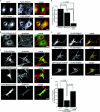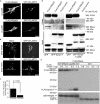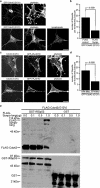Synaptopodin protects against proteinuria by disrupting Cdc42:IRSp53:Mena signaling complexes in kidney podocytes
- PMID: 17569780
- PMCID: PMC1934530
- DOI: 10.2353/ajpath.2007.070075
Synaptopodin protects against proteinuria by disrupting Cdc42:IRSp53:Mena signaling complexes in kidney podocytes
Abstract
The actin-based foot processes of kidney podocytes and the interposed slit diaphragm form the final barrier to proteinuria. Mutations affecting several podocyte proteins cause disruption of the filtration barrier and rearrangement of the highly dynamic podocyte actin cytoskeleton. Proteins regulating the plasticity of the podocyte actin cytoskeleton are therefore of critical importance for sustained kidney barrier function. Synaptopodin is an actin-associated protein essential for the integrity of the podocyte actin cytoskeleton because synaptopodin-deficient mice display impaired recovery from protamine sulfate-induced foot process effacement and lipopolysaccharide-induced nephrotic syndrome. Moreover, bigenic heterozygosity for synaptopodin and CD2AP is sufficient to induce spontaneous proteinuria and focal segmental glomerulosclerosis-like glomerular damage in mice. Mechanistically, synaptopodin induces stress fibers by blocking the proteasomal degradation of RhoA. Here we show that synaptopodin directly binds to IRSp53 and suppresses Cdc42:IRSp53:Mena-initiated filopodia formation by blocking the binding of Cdc42 and Mena to IRSp53. The Mena inhibitor FP(4)-Mito suppresses aberrant filopodia formation in synaptopodin knockdown podocytes, and when delivered into mice protects against lipopolysaccharide-induced proteinuria. The identification of synaptopodin as an inhibitor of Cdc42:IRSp53:Mena signaling defines a novel antiproteinuric signaling pathway and offers new targets for the development of antiproteinuric therapeutic modalities.
Figures






Similar articles
-
KANK deficiency leads to podocyte dysfunction and nephrotic syndrome.J Clin Invest. 2015 Jun;125(6):2375-84. doi: 10.1172/JCI79504. Epub 2015 May 11. J Clin Invest. 2015. PMID: 25961457 Free PMC article.
-
Role of γ-adducin in actin cytoskeleton rearrangements in podocyte pathophysiology.Am J Physiol Renal Physiol. 2021 Jan 1;320(1):F97-F113. doi: 10.1152/ajprenal.00423.2020. Epub 2020 Dec 14. Am J Physiol Renal Physiol. 2021. PMID: 33308016 Free PMC article.
-
Synaptopodin orchestrates actin organization and cell motility via regulation of RhoA signalling.Nat Cell Biol. 2006 May;8(5):485-91. doi: 10.1038/ncb1400. Epub 2006 Apr 16. Nat Cell Biol. 2006. PMID: 16622418
-
Actin up: regulation of podocyte structure and function by components of the actin cytoskeleton.Trends Cell Biol. 2007 Sep;17(9):428-37. doi: 10.1016/j.tcb.2007.06.006. Epub 2007 Sep 4. Trends Cell Biol. 2007. PMID: 17804239 Review.
-
CD2-associated protein and glomerular disease.Lancet. 2003 Nov 22;362(9397):1746-8. doi: 10.1016/S0140-6736(03)14856-8. Lancet. 2003. PMID: 14643126 Review.
Cited by
-
Signaling from the podocyte intercellular junction to the actin cytoskeleton.Semin Nephrol. 2012 Jul;32(4):307-18. doi: 10.1016/j.semnephrol.2012.06.002. Semin Nephrol. 2012. PMID: 22958485 Free PMC article. Review.
-
Abnormal Crosstalk between Endothelial Cells and Podocytes Mediates Tyrosine Kinase Inhibitor (TKI)-Induced Nephrotoxicity.Cells. 2021 Apr 12;10(4):869. doi: 10.3390/cells10040869. Cells. 2021. PMID: 33921219 Free PMC article. Review.
-
Podocyte-actin dynamics in health and disease.Nat Rev Nephrol. 2016 Nov;12(11):692-710. doi: 10.1038/nrneph.2016.127. Epub 2016 Aug 30. Nat Rev Nephrol. 2016. PMID: 27573725 Review.
-
Cellular Recruitment by Podocyte-Derived Pro-migratory Factors in Assembly of the Human Renal Filter.iScience. 2019 Oct 25;20:402-414. doi: 10.1016/j.isci.2019.09.029. Epub 2019 Sep 26. iScience. 2019. PMID: 31622881 Free PMC article.
-
Regulation of podocyte BK(Ca) channels by synaptopodin, Rho, and actin microfilaments.Am J Physiol Renal Physiol. 2010 Sep;299(3):F594-604. doi: 10.1152/ajprenal.00206.2010. Epub 2010 Jul 14. Am J Physiol Renal Physiol. 2010. PMID: 20630939 Free PMC article.
References
-
- Mundel P, Kriz W. Structure and function of podocytes: an update. Anat Embryol (Berl) 1995;192:385–397. - PubMed
-
- Somlo S, Mundel P. Getting a foothold in nephrotic syndrome. Nat Genet. 2000;24:333–335. - PubMed
-
- Drenckhahn D, Franke RP. Ultrastructural organization of contractile and cytoskeletal proteins in glomerular podocytes of chicken, rat, and man. Lab Invest. 1988;59:673–682. - PubMed
-
- Oh J, Reiser J, Mundel P. Dynamic (re)organization of the podocyte actin cytoskeleton in the nephrotic syndrome. Pediatr Nephrol. 2004;19:130–137. - PubMed
Publication types
MeSH terms
Substances
Grants and funding
LinkOut - more resources
Full Text Sources
Other Literature Sources
Research Materials
Miscellaneous

